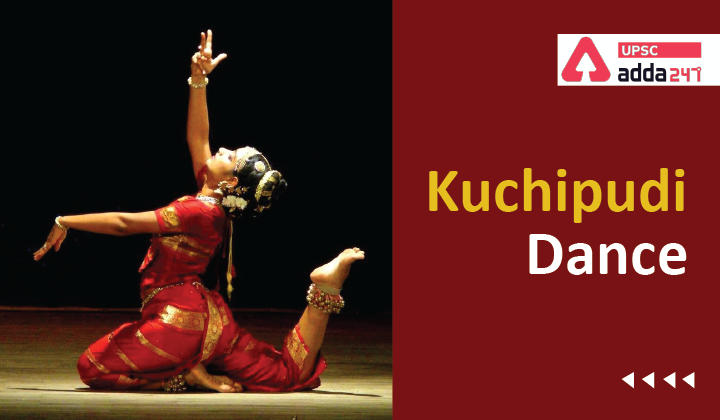Table of Contents
Kuchipudi Dance- Relevance for UPSC Exam
- GS Paper 1: Indian History- Indian culture will cover the salient aspects of Art Forms, Literature and Architecture from ancient to modern times.
Kuchipudi Dance
- Kuchipudi is one of the eight classical styles of Indian dance. Kuchipudi dance derives its name from a village in the Krishna district of Andhra Pradesh.
- Kuchipudi largely developed as a Hindu god Krishna-oriented Vaishnavism tradition, and it is most closely related to Bhagavata Mela.
- To show the dexterity of the dancers in footwork and their control and balance over their bodies, techniques like dancing on the rim of a brass plate and with a pitcher full of water on the head are used in the Kuchipudi dance.
- Accompanying Music and Musical instruments: Kuchipudi dance is accompanied by the classical school of Carnatic music. The accompanying musicians, besides the vocalist are-
- A mridangam player to provide percussion music,
- A violin or veena player or both for providing instrumental melodic music, and
- A cymbal player who usually conducts the orchestra and recites the sollukattus (mnemonic rhythm syllables).
- Famous Exponents: Indrani Bajpai (Indrani Rahman) is a famous exponent of Kuchipudi Dance who promoted Kuchipudi art through public performances outside Andhra.
- Vempati Chinna Satyam is a legendary dancer and guru of Kuchipudi dance form.
- Other famous proponents of Kuchipudi Dance include- Raja and Radha Reddy, their daughter Yamini Reddy; Kaushalya Reddy; Bhavana Reddy, etc.
Get Free Study Material for UPSC and State PCS Examinations
Kuchipudi Dance- Background
- Around the third and fourth decade of this century, Kuchipudi dance emerged out of a long rich tradition of dance-drama of the same name.
- In 17th century Kuchipudi style of Yakshagaana was conceived by Siddhendra Yogi a talented Vaishnava poet and visionary.
- He was steeped in the literary Yakshagaana tradition being guided by his guru Teerthanaaraayana Yogi who composed the Krishna-Leelatarangini, a kaavya in Sanskrit.
- It is said that Siddhendra Yogi had a dream in which Lord Krishna asked him to compose a dance drama based on the myth of the bringing of paarijaata flower for Sathyabhaama.
- Siddhendra Yogi initiated young Brahmin boys of Kuchipudi village to practice and perform his compositions particularly Bhaamaakalaapam.
Kathak Dance | Indian Classical Dances
Kuchipudi Dance- Key Features and Flow of Dancing
- A recital of Kuchipudi begins with an invocatory number, as is done in some other classical dance styles.
- Earlier the invocation was limited to Ganesha Vandana. Now other gods are also invoked.
- It is followed by nritta, that is, non-narrative and abstract dancing. Usually, jatiswaram is performed as the nritta number.
- Next is presented a narrative number called shabdam. One of the favourite traditional shabdam number is the Dashaavataara.
- The Shabdam is followed by a natya number called
- Many Kuchipudi dancers prefer to perform entry of Satyabhama from the traditional dance-drama Bhaamaakalaapam.
- Next in the sequence comes a pure nritya abhinaya number based on literary-cum musical forms like padam, jaavli, shlokam, etc.
- In such a number each of the sung words is delineated in space through dance, drishya-kavita (visual poetry).
- A Kuchipudi recital is usually concluded with Excerpts of Krishna-leela-tarangini are sung with this number.
- In this the dancer usually stands on a brass plate locking the feet in shakatavadanam paada and moves the plate rhythmically with great dexterity.
Bharatanatyam- Indian Classical Dance




 TSPSC Group 1 Question Paper 2024, Downl...
TSPSC Group 1 Question Paper 2024, Downl...
 TSPSC Group 1 Answer key 2024 Out, Downl...
TSPSC Group 1 Answer key 2024 Out, Downl...
 UPSC Prelims 2024 Question Paper, Downlo...
UPSC Prelims 2024 Question Paper, Downlo...




